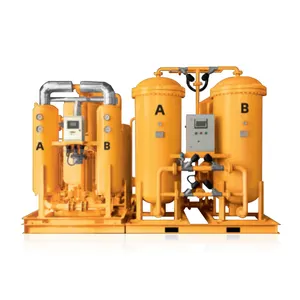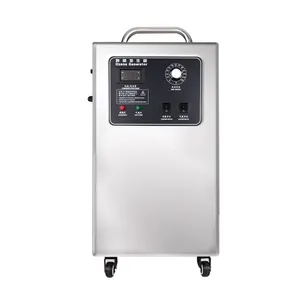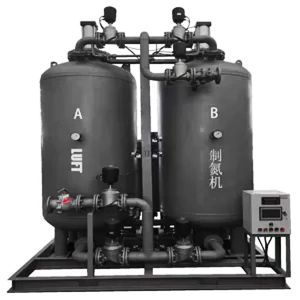(4371 products available)























































































































































































































Market Overview: The industrial oxygen generator market has been experiencing notable growth, driven by increasing demand across various sectors, including manufacturing and metal cutting. According to Research and Markets, the market size was estimated at $477.46 million in 2024 and is projected to reach $654.36 million by 2030, reflecting a compound annual growth rate (CAGR) of 5.4%. This growth is largely influenced by the rising need for efficient and cost-effective oxygen generation solutions, spurred by stringent environmental regulations and the need for sustainable industrial practices. Moreover, the Asia-Pacific region is expected to be a significant growth driver, as rapid industrialization and improved environmental governance create a favorable landscape for oxygen generator adoption.
Market Insights: Consumer behavior is shifting towards more sustainable practices, prompting companies to invest in industrial oxygen generators that not only meet operational needs but also align with environmental standards. The demand for these generators is further bolstered by advancements in technology that enhance efficiency and reduce operational costs. However, challenges such as high initial installation costs and the complexity of maintenance remain prevalent. Companies are focusing on addressing these pain points by offering integrated solutions that streamline installation and minimize downtime. The competitive landscape features key players who are innovating to provide advanced systems, ensuring they remain relevant in this evolving market. With ongoing technological advancements and a growing emphasis on sustainability, the industrial oxygen generator price market is poised for continued expansion.
An industrial oxygen generator produces oxygen through a physical process. There are two main types of generators: cryogenic oxygen generators and non-cryogenic oxygen generators.
The unique specifications of an industrial oxygen generator for sale will influence its performance, application, and maintenance requirements.
Common specifications for oxygen generators include:
Industrial oxygen generators require regular maintenance for optimal performance, continuous operation, and extended lifespan. Some of the maintenance tips include:
Some of the many industries that use industrial oxygen generators include the following.
Medical
Hospitals use industrial oxygen generators to ensure a steady supply of oxygen. A generator provides supplemental or therapeutic oxygen to patients when the liquid oxygen storage is low.
Marine and underwater
A divers' oxygen generator creates and supplies oxygen for divers or underwater workers staying underwater for long periods. It is also used in submarines to provide breathable air for the crew.
Aquaculture
A fish oxygen generator boosts oxygen levels in fish farms or aquaculture systems. Increased oxygen promotes fish growth and reduces mortality rates.
Mining
Mining industries use industrial oxygen generators to produce oxygen at the miners' site. It improves ventilation and decreases the quantity of harmful gases, like methane and carbon monoxide.
Metal fabrication
Metal industries use oxygen generators for metal welding and cutting. Oxygen enhances the heat produced by the fuel gas, which raises the flames used for cutting and welding metals effectively.
Water treatment
Municipal water treatment facilities use oxygen generators to increase the dissolved oxygen levels of stagnant or low oxygen levels in water to enhance the activities of oxygen-dependent microorganisms.
Pharmaceuticals
Pharmaceutical companies use industrial oxygen generators to create oxygen for enhancing the growth of certain microorganisms or cell cultures used in drug production and fermentation processes.
Glass manufacturing
The glass manufacturing industry also use oxygen generators in glass manufacturing furnaces. The generators improve combustion efficiency, decrease fuel consumption, and enhance glass quality.
Robotics
A robot oxygen generator generates oxygen to power robots or drones used for long-range exploration and search missions.
Aerospace
Aerospace industries use industrial oxygen generators in spacecrafts and rockets. The generator provides oxygen for crew members or supports combustion in propulsion systems.
When purchasing an industrial oxygen generation system, it is important to take several elements into account to ensure the chosen model meets specific application needs and supply requirements. Here are some tips on how to choose an industrial oxygen generator:
Application requirement analysis:
Users need to take some time to thoroughly analyze and understand the application's specific needs, focusing on the required oxygen purity and supply pressure. Different industries and use scenarios may demand distinct oxygen quality and pressure levels. For instance, medical institutions such as hospitals or healthcare facilities must ensure that the oxygen generated is of pharmaceutical grade to meet the precise requirements of patients. Similarly, industries like water treatment, welding, or chemical manufacturing may have specific purity and pressure demands. By carefully considering these factors, users can select an industrial oxygen generator that delivers the oxygen purity and pressure required for their particular application, ensuring optimal performance and compliance with industry standards.
Oxygen generator system types:
Users should familiarize themselves with the various types of industrial oxygen generators available and choose one that suits their needs. Membrane separation units are compact and simple, suitable for applications that do not have high purity requirements. Pressure swing adsorption (PSA) oxygen generators can provide high-purity oxygen, which is suitable for use in various industries. Users should carefully assess the advantages and disadvantages of different types of generators and select the appropriate model based on their specific application requirements.
Consideration of device size and weight:
When choosing an industrial oxygen generator, the size and weight of the device need to be taken into account, particularly for those whose applications require mobility or limited installation space. Mobile devices offer the flexibility to move the generator to different locations as needed. On the other hand, compact units are designed to occupy less floor space and are more suitable for installation in areas where available space is limited. By considering these factors, users can choose a generator that fits their spatial constraints and operational needs.
Energy consumption and operating cost comparison:
Users should consider the energy consumption and operating costs of the oxygen generator. Different models may have different energy consumption rates, which affects operating costs. Additionally, factors such as the lifespan and replacement cost of consumable components like adsorbents or membranes should be evaluated. By taking these factors into account, users can choose a generator that is economically efficient and helps reduce operating expenses.
Maintenance and technical support:
When selecting an industrial oxygen generator, users should consider the availability of maintenance and technical support services. Regular maintenance is vital to ensure optimal performance and reliable operation of the generator over the long term. Users may wish to investigate the service network and support resources offered by the supplier to ensure timely and efficient assistance when needed. This way, users can have greater peace of mind and confidence in the continued operation of their equipment.
User review and comparison:
When selecting an industrial oxygen generator, users can refer to other customers' comments and experiences to understand better the performance and reliability of different brands and models. Conducting a comparison of various options helps users make a well-informed choice that meets their specific needs and expectations.
Q1: What is the working principle of an industrial oxygen generator?
A1: The oxygen generator uses pressure swing adsorption technology to separate oxygen from the air by changing the pressure.
Q2: What is the source of oxygen for an industrial oxygen generator?
A2: The industrial oxygen generator takes oxygen from the ambient air through a separation process.
Q3: Does an industrial oxygen generator produce pure oxygen?
A3: Yes, the industrial oxygen generator can produce high-purity oxygen, typically 90% to 95% purity, depending on the specific design and technology used.
Q4: What are the benefits of using an industrial oxygen generator?
A4: The benefits of using an industrial oxygen generator include a continuous oxygen supply, reduced transportation costs, high purity, and environmental sustainability.